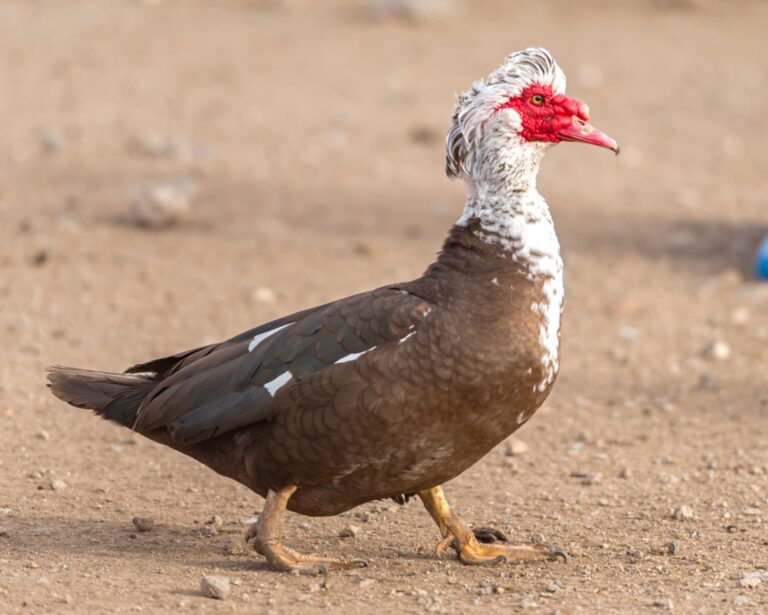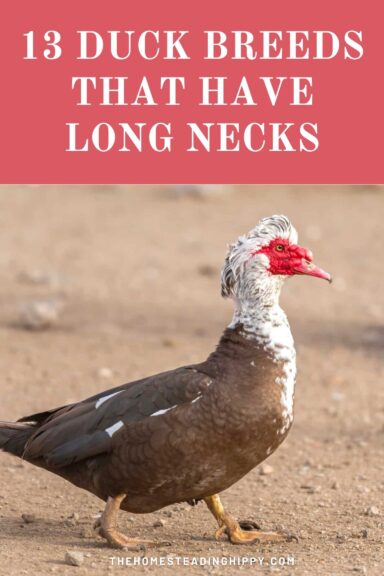When it comes to keeping poultry, ducks have advantages all their own. And although you won’t see as many domestic breeds as you will with chickens, there’s still a huge variety out there to consider. Some of the coolest ducks around are those with long necks.

These long-necked birds have a graceful, swan-like appearance, but it isn’t just there for our enjoyment; the long necks serve a very utilitarian purpose by allowing these ducks to reach food on the bottom of a body of water, or scoop mud out of the way looking for the same.
Keep reading, and I’ll tell you about some really cool long-necked duck breeds you can find in the wild or on homesteads.
Muscovy Ducks
Muscovies (Cairina moschata) are some of the most remarkable ducks around, partly because there are domesticated and wild varieties that share basically the same features.
They’re immediately notable for the bright red, fleshy growths covering their face and part of their bill, their large and stocky build, and also their substantial claws on each foot that help them perch and nest in trees. They also make a pretty good weapon!
These long-necked ducks are in reality more closely related to geese, but they’ve been domesticated and kept as poultry so long that they are honorary members of the duck category for practical purposes.
They’ve been raised for centuries for their meat and eggs and are notable for being extremely quiet, making them great if you want to keep the racket down on your homestead.
Black-bellied Whistling Duck
A gorgeous and regal wild duck, the Black-bellied Whistling Duck (Dendrocygna autumnalis) is found throughout the Americas and is a fairly common sight in North America.
They are easily distinguished by their rusty-red breast, back, and neck, and a jet-black underside. And because they are on our list, you already know they have a very long neck, notable for carrying the head perfectly vertical.
In the wild, they are voracious eaters of aquatic vegetation and life, routinely preying on shrimp, mussels, small fish, duckweed, lilies, and a lot more. These are diving ducks, and so you’ll commonly see them disappear beneath the surface for 15 to 20 seconds while searching for their food.
Fulvous Whistling Duck
A wild duck that is pretty common throughout the Western Hemisphere, the Fulvous Whistling Duck (Dendrocygna bicolor) is a breed with a high-pitched, shrill call that is totally unlike the quacking we are used to out of other ducks.
If you live in Florida or anywhere in the Caribbean, these ducks will be a pretty common sight, though they are somewhat rarer in other Southern states.
Although their coloration is not particularly remarkable, they have a long and gently curving neck that is almost swan-like in its profile and proportions.
These ducks need it because they’re critically important in wetland ecosystems due to their foraging behavior. They dabble on the water and also sift through mud and soft soil on land, and so they need that long neck for leverage.
Ruddy Shelduck
The Ruddy Shelduck (Tadorna ferruginea) – and no, that isn’t a misspelling – is a wild breed native to Eastern Europe and Western Asia and is most often recognized for its highly gregarious nature.
They are large for a wild breed, measuring about 2 ft long and weighing over three pounds. Males and females alike have distinctive ocher brown and tan feathers that are darker at the bottom and lighter at the top, terminating in a cream color around the eyes.
The legs, bills, and tail feathers are jet black, giving these birds a pleasing look. Females are considerably lighter in color than males though.
These are migratory ducks that can be found seasonally much farther south from their usual home range, as far away as Africa. But even though they migrate, current populations are shrinking due to the disruption of their typical habitats on both continents.
Chances are you won’t see one of these beautiful and intriguing ducks in America, but they aren’t entirely unheard of, either!
Indian Runner
Without question, one of the coolest and most interesting ducks you’ll find anywhere, this domestic breed is immediately recognizable by its long, slender, and upright body plan, and that includes a very long neck. Lots of folks think they look like the duck version of a penguin!
As the name suggests, Indian Runners (Anas platyrhynchos domesticus) actually run everywhere; they don’t waddle like normal ducks when on land. They’re surprisingly fast too, and can easily get away from you if they don’t want you touching them or coming near.
But you don’t have to worry about that because they are curious, playful, and known to be affectionate with people as long as you raise them right. A great choice for a backyard flock!
White-faced Whistling Duck
The African White-faced Whistling Duck (Dendrocygna viduata) is sure appropriately named. It has a stark, ivory-white face and a beautifully contrasting dark blue bill and also makes a shrill, almost shrieking, high-pitched call.
Somewhat concerning, they usually make this call right before dawn and after dusk; it can definitely give you the creeps!
These wild ducks are also noteworthy for their extremely large flocks, and it’s not uncommon to see hundreds of them floating together out in the middle of a river, large pond, or lake.
These ducks are primarily plant eaters, and once they’ve stripped an area of the choice bits, they’ll take off in search of more food, sometimes traveling great distances to known areas that have what they want.
Indian Spot-billed Duck
Not to be confused with the Indian Runner found elsewhere on our list, the Indian Spot-billed (Anas poecilorhyncha) is a resident of Asia that is known for its subdued coloring in both males and females – save for the bright yellow and black beak and red patches just behind the bill. It kind of reminds me of the German flag!
A medium breed, these ducks have a conventional build with a gently sloping back, narrow breast, and firm build.
Aside from the color, they remind you of a somewhat larger mallard, but with one obvious difference: their necks are almost three times longer than that of a typical mallard.
Commonly seen around all freshwater sources, unfortunately, the Indian Spot-billed is facing challenges due to habitat loss. Especially concerning because they don’t migrate!
Plumed Whistling Duck
This Australian native, Dendrocygna eytoni, has plenty of special physical characteristics. They have stout, long pink legs that look almost like flamingos’, frilled wing feathers, and extremely long, thick, and strong necks.
Sometimes referred to as grass whistling ducks or just grass ducks, they are a common sight near all freshwater features where they tend to congregate in huge flocks. Interestingly, most of their food is found on land in the form of grass.
They will graze repeatedly, and for hours, like sheep or goats will! In fact, you might wake up to a “mown lawn” because they tend to do most of their feeding at night.
Northern Pintail
An iconic and beautiful duck that is greatly beloved by bird watchers, the Northern Pintail (Anas acuta) is most remarkable for its gorgeous black, white, and gray coloration across its entire body and also its spiny, spiky feathers at the end of the wings and tail, the latter of which looks like a single long needle or antenna extending off their backside.
These migratory birds can be found all over, throughout continental Europe, much of Asia, and North America.
Freshwater marshes and wetlands are some of their favorite hangouts as they are known to eat a diet that is high in all kinds of invertebrates and specific aquatic plants. They really are gorgeous, and their long, graceful necks only add to that appeal.
Eastern Spot-billed Duck
These gorgeous, long-necked ducks (Anas poecilorhyncha) are notable for the bright white and pale gray color of their necks, black mask markings, and scale-like tan and brown coloration on their bodies.
They also have bright orange legs and indigo-blue rectangles of feathers at the base of their wings. They really do look distinctive!
Found all throughout Asia, from China through most of Russia, you might think of this breed as the Eurasian equivalent of the mallard; they make the same kind of quacking call, have a similar breeding season, and build their nests on the ground close to water in the same way.
They are seasonally monogamous, but males stick around to guard the females, the eggs, and the nest until they have hatched, again just like mallards.
White-winged Duck
White-wings (Asarcornis scutulata) are among the largest and heaviest wild ducks in the world, and they stand quite tall from foot to head thanks to their long, curving neck. Some large drakes can stand nearly 3 ft tall!
Found throughout Southern and Southeastern Asia, these marvelous birds got their name thanks to the flashing, contrasting white color on their wings that consist of white and gray fields separated by a black bar.
The heads of males are a speckled pied, set off by their bright orange eyes and mottled yellow beak. They are truly impressive specimens, but you’ll have to work hard to spot one because they tend to be most active at night and they are also, sadly, on the endangered species list.
Wandering Whistling Duck
A medium-sized wild breed, the Wandering Whistling Duck (Dendrocygna arcuata) has a mostly upright posture, long legs, a long and straight neck, and a long, piercing, almost mournful call.
Found throughout the Pacific rim, including Australia, Papua New Guinea, and the Philippines, the Wandering Whistling Duck looks like it’s standing at attention, or perhaps waiting for its lost loved one to come home.
Even more remarkable is the fact that their wings make an audible whistling sound when they are in flight. Sounds crazy, but it’s true!
They tend to be found in the most interesting places wherever there’s plenty of water: areas that chronically flood, secluded lagoons, and dam reservoirs are some of their favorite environments.
Lesser Whistling Duck
Yet another whistling duck (Dendrocygna javanica) on our list, and another Asian breed, you’ll usually find these long-necked, graceful beauties near shallow ponds, lakes, flooded fields, and streams.
They essentially look like a miniaturized version of the Fulvous Whistling Duck found elsewhere on our list, but the coloration of the tails is slightly different, and the undercarriage is a darker, rust color verging on orange.
They’re also notable for their peculiar call: it is short, clipped, and repetitive, very much unlike the long, loud whistle of other whistling ducks. Don’t look for their nests on land, either: they tend to place them in hollow tree trunks or the holes left behind from fallen branches.

Tim is a farm boy with vast experience on homesteads, and with survival and prepping. He lives a self-reliant lifestyle along with his aging mother in a quiet and very conservative little town in Ohio. He teaches folks about security, prepping and self-sufficiency not just through his witty writing, but also in person.
Find out more about Tim and the rest of the crew here.
